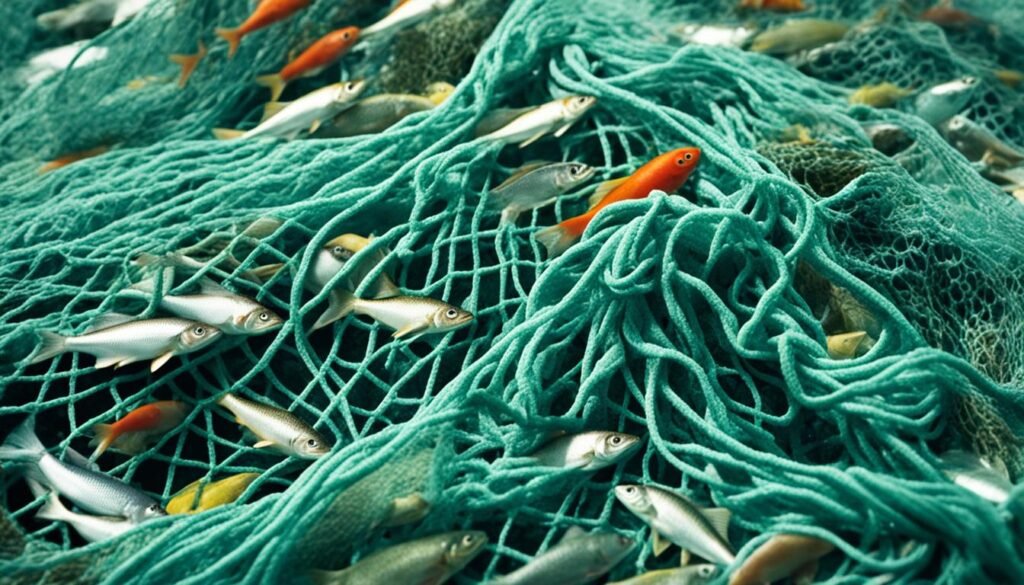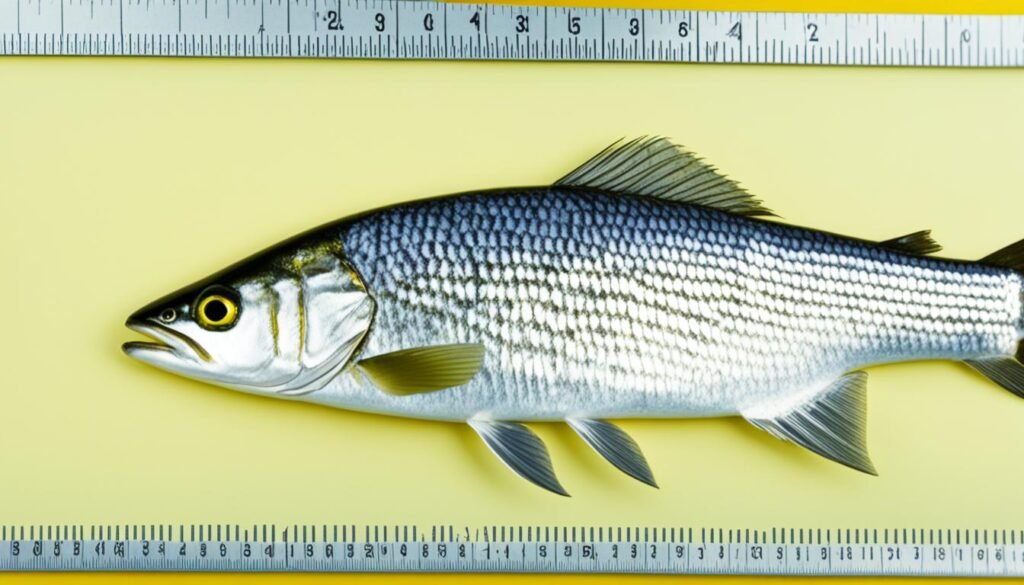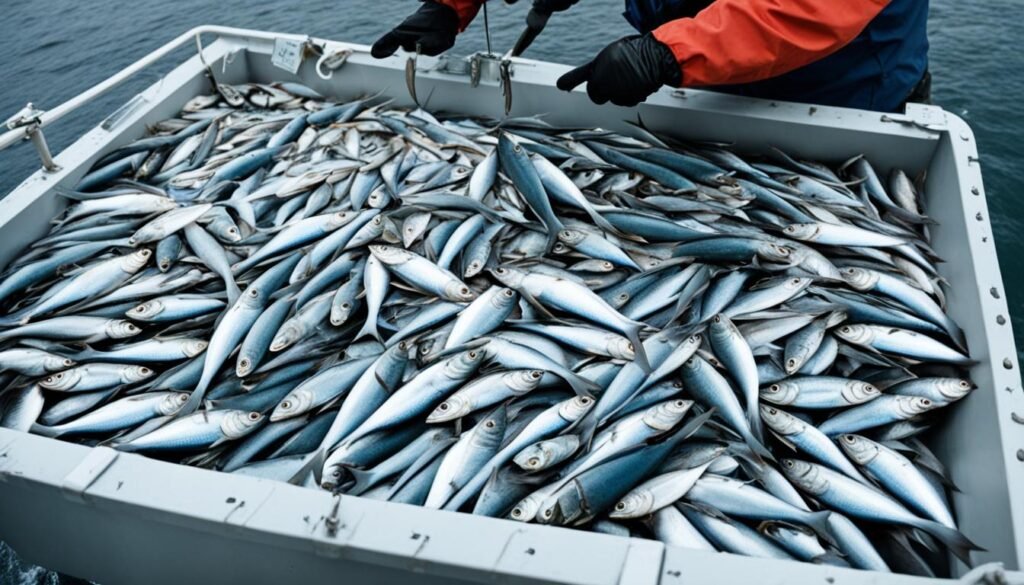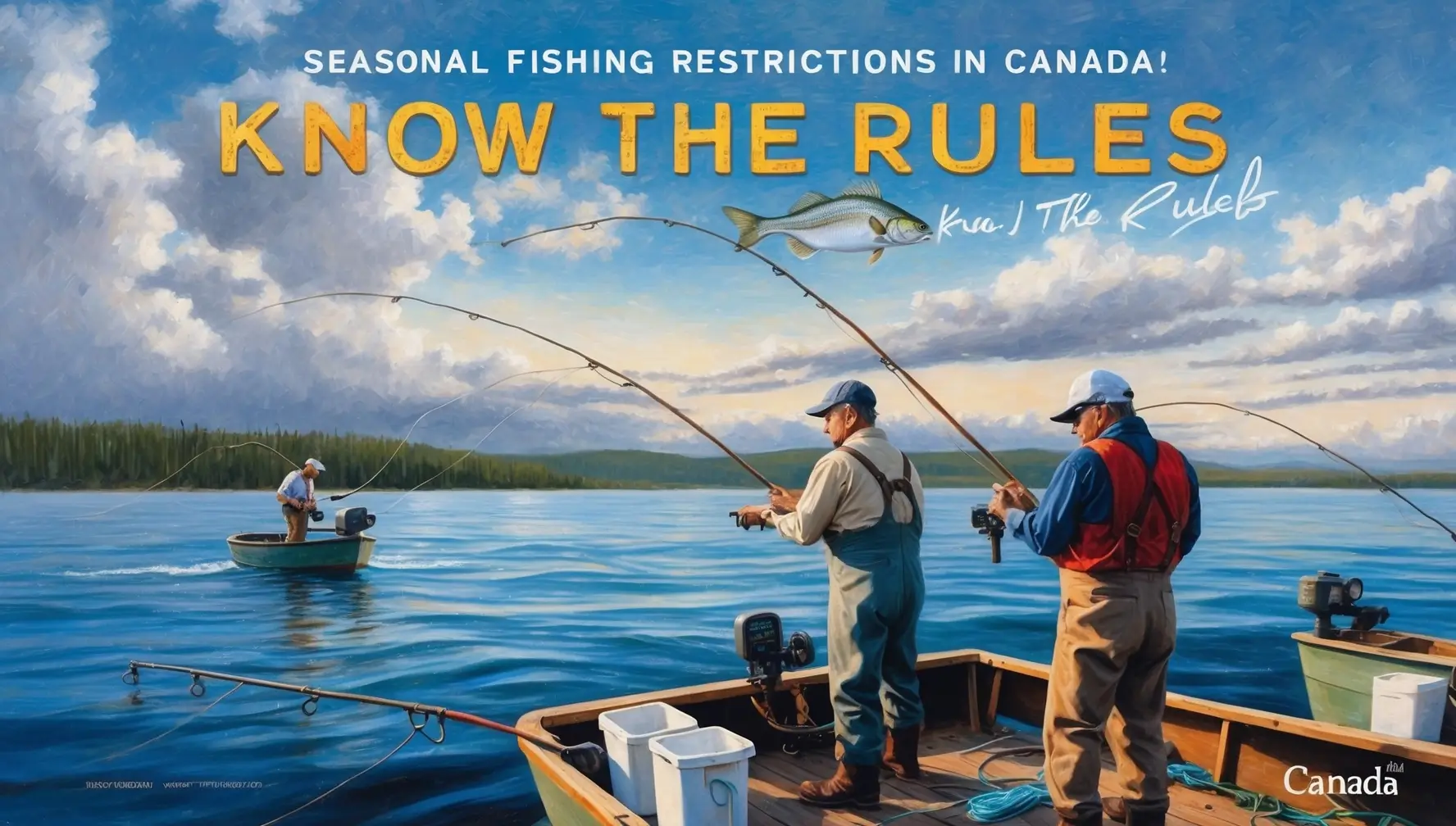Planning a fishing trip in Canada?
Knowing the country’s fishing laws is key. These rules ensure a great and responsible time on the water.
Canadian fishing regulations can be complex. They include seasonal closures, catch limits, and size restrictions. These rules protect fish and promote sustainability.
Key Takeaways about Seasonal Fishing Restrictions in Canada
- Recreational fishing in Canada is governed by both federal and provincial/territorial regulations.
- Seasonal closures, catch and possession limits, and size restrictions are in place to protect fish populations and promote sustainability.
- Anglers must familiarize themselves with the specific rules for the region they plan to fish in order to avoid penalties and ensure compliance.
- Understanding and adhering to these regulations is essential for responsible and enjoyable fishing experiences in Canada.
- Anglers should consult official fishing guides and licenses to stay informed about the latest updates and changes to the rules.
Understanding Canada’s Recreational Fishing Regulations
Canada’s recreational fishing rules can be tricky. Both federal and provincial governments manage fisheries. Anglers need to check both sets of rules before fishing.
Federal, Provincial, and Territorial Responsibilities
The Fisheries and Coastal Resources Act sets federal Recreational Fishing Laws. It covers catch limits, fishing spots, and seasons. Two other acts help manage recreational fisheries.
Provinces and territories issue Fishing Licenses. They also make local rules. Nova Scotia’s Sportfishing Licensing Regulations cover fees and special provisions.
Importance of Consulting Anglers’ Guides and Licenses
Anglers must check current Anglers’ Guides and get proper Fishing Licenses. These give key info on rules, catch limits, and seasons for each area.
By knowing government roles and checking guides, anglers can follow Fisheries Regulations. This ensures legal fishing in Canada.
| Licence Type | Resident | Resident Veterans | Canadian Non-resident | Non-resident Alien |
|---|---|---|---|---|
| Annual Sportfishing Licence | $36.83 | Free | $66.51 | $97.39 |
| 1-Day Sportfishing Licence | $13.81 | Free | $13.81 | $22.79 |
| 3-Day Sportfishing Licence | $22.79 | Free | $22.79 | $36.59 |
Note: Fees are in Canadian dollars. They don’t include the 5% federal Goods and Services Tax.
“Fishing is more than a sport. It connects us to nature and passes down traditions. Knowing fishing rules keeps this pastime sustainable and fun.”
– [Anglers’ Guide Expert, Fisheries and Oceans Canada]
Seasonal Fishing Restrictions in Canada
Canadian anglers must follow complex seasonal fishing rules across the country. These rules protect fish populations during spawning periods. Federal, provincial, and territorial authorities set these restrictions.
Each area has its own rules for open and closed fishing seasons. Some rules are specific to certain fish species. Breaking these rules can lead to big fines.
Anglers should learn the rules for where they plan to fish. They can find this info in guides, online, or by asking local authorities.
Exploring Seasonal Fishing Regulations
Many Canadian provinces offer online resources about fishing rules. These often include yearly updates and downloadable guides. Some have web apps to find rules for specific waters.
These resources usually cover fishing seasons, bait rules, and catch limits. They may also have searchable databases and alerts about closures.
- Annual updates to sportfishing regulations
- Ability to download or view a PDF guide of the regulations
- Web-based applications for accessing fishing regulations by specific waterbody
- Information on fishing seasons, bait rules, possession and size limits for each species
- Searchable databases to find regulations for a particular area or waterbody
- Alerts on sportfishery closures and other important updates
Alberta’s government offers yearly sportfishing rule updates. Anglers can download a PDF guide or use a web app. The app shows rules for specific waters, including seasons and catch limits.
New Brunswick has special rules for some lakes. These may limit gas-powered vehicles or set line requirements. Anglers should check local rules before fishing.
Fishing rules vary across Canada. Anglers must check with local authorities to fish legally and help manage fisheries.
Catch Limits and Possession Limits

Canadian anglers must know the Catch Limits and Possession Limits for their target species and region. Catch limits set the daily max for keeping fish. Possession limits cap the total fish an angler can have at any time.
Catch Limit: Daily Allowance
The Catch Limit is the max number of fish an angler can keep in one day. These limits help maintain fish populations and promote responsible angling. Limits vary by species and region.
Possession Limit: Total Allowance
The Possession Limit is the max fish an angler can have at any time. This includes fish in coolers, homes, or elsewhere. Following these limits helps keep fish populations healthy.
Anglers must know the specific limits for their target species and region. These rules can differ across provinces, territories, and water bodies. Check local regulations to stay within legal limits.
“Sustainable fishing practices, including adhering to catch and possession limits, are crucial for the long-term health of Canada’s fisheries and the enjoyment of the sport for generations to come.”
Size Restrictions for Fish

Canada’s fishing rules include size limits for certain fish species. These limits protect fish populations by keeping smaller fish in the water. Anglers must know how to measure their catch correctly.
Protecting Spawning and Prime Spawning Fish
Size rules, like minimum lengths or “slot” limits, vary by region and species. These rules keep young fish and large “trophy” fish safe to reproduce. Anglers must follow Fish Size Limits and Slot Limits for Spawning Fish Protection.
Measuring Fish Length Accurately
Correct fish measurement is key to following size rules. Measure from the closed mouth tip to the compressed tail fin end. Use a bump board or tape measure for accuracy.
| Fish Species | Minimum Length | Slot Limit |
|---|---|---|
| Walleye | 35 cm | 40-60 cm |
| Northern Pike | 70 cm | 75-110 cm |
| Largemouth Bass | 40 cm | 40-55 cm |
| Smallmouth Bass | 35 cm | 35-50 cm |
This table shows examples of Fish Size Limits and Slot Limits for popular Canadian game fish. Following these rules helps keep our fisheries healthy for years to come.
“Protecting our fisheries is everyone’s job. By following size limits, anglers help save these precious natural resources.”
Proper Fish Release Techniques

Anglers must release fish due to regulations or personal choice. It’s vital to use proper techniques to minimize stress and injury. Knowing catch-and-release guidelines increases the fish’s chance of survival.
When Fish Must Be Released
Fish must be released if caught out of season or exceeding size limits. Protected species must also be let go. A 2000 Ontario study found 95% of anglers practice catch-and-release to some extent.
Catch and Release Guidelines
To ensure successful fish release, follow these guidelines:
- Minimize air exposure: Keep the fish in water while unhooking.
- Use appropriate landing equipment: Use a rubberized net or wet hands.
- Carefully remove hooks: Use hook removal tools gently.
Most fish mortality occurs after release, even if they seem healthy. Circle hooks can reduce overall mortality rates by about 50%. Barbless hooks are recommended to decrease catch-and-release mortality.
A review of 118 studies showed average mortality for catch-and-release angling was 16.2%. Proper fish handling techniques can greatly improve fish survival rates. This contributes to sustainable fishing practices.
Culling and Livewell Regulations

Anglers can sometimes hold and release fish in their livewell to improve their catch. This practice, called culling, applies to walleye, northern pike, and bass. It follows strict rules.
Conditions for Culling Certain Species
Livewells must meet specific requirements. Anglers can’t exceed daily catch limits for culled species. The Alberta Fisheries Regulation act sets quotas for each fish species.
Retained fish include those not immediately returned to water. This covers fish in buckets, on stringers, or in livewells. Culling to stay under the limit is illegal.
Fish kept and later released still count towards the daily limit. The ESRD confirms this in the Guide to Sportfishing Regulations. Releasing fish doesn’t remove them from the possession limit.
There’s no legal way to subtract retained fish from the daily limit. Anglers should know the rules for fish culling, livewell use, and selective harvest. This ensures compliance and sustainable fishing in their area.
Sustainable Fishing and Conservation Measures
Responsible anglers in Canada help conserve fisheries resources. They follow regulations, practice catch-and-release, and support conservation efforts. These actions ensure long-term sustainability of recreational fishing.
Canada’s fisheries management relies on five key areas. These include planning, science-based decisions, managing environmental impacts, enforcing rules, and monitoring results. Management plans consider fish stock biology, catch limits, and gear regulations.
Canadian scientists work with universities and global organizations. They gather data for informed fisheries management decisions. This focus on sustainability has made fish products a major export.
Canada aims to protect 25% of marine areas by 2025. The goal increases to 30% by 2030. Currently, 13.8% of marine areas are conserved.
Canada’s third-party certification for sustainable fisheries surpasses global averages. It’s much higher than the 14% worldwide. This shows Canada’s commitment to balancing economy and ecology.
| Sustainable Fishing Practices | Fish Conservation Efforts | Fisheries Management Initiatives |
|---|---|---|
| – Adherence to fishing regulations – Catch-and-release techniques – Supporting conservation programs | – Protecting fish habitats – Monitoring fish populations – Establishing conservation areas | – Science-based decision-making – Enforcing fishing rules – International collaboration |
The sustainable fishing model in Canada serves as a blueprint for responsible resource management, ensuring the long-term viability of the country’s fisheries and the preservation of its marine ecosystems.
“Sustainable fishing is not just about catching fish, but also about preserving the health and diversity of our aquatic environments for generations to come.”
For an overview of fishing regulations and licenses in Canada, please check this guide
Conclusion
Canada’s fishing rules may seem complex, but they protect our aquatic ecosystems. Anglers should know the seasons, catch limits, and size restrictions. Understanding these guidelines helps preserve our fisheries for future generations.
Regulations safeguard vulnerable fish populations and marine environments. By following Recreational Fishing in Canada principles, anglers can enjoy the sport responsibly. This approach ensures the continued thrill of Fishing Regulations in our diverse waterways.
Staying informed about fisheries management is crucial for anglers. It helps preserve the health of Canada’s recreational fisheries. Our collective efforts in sustainable practices will protect our aquatic landscapes.
Together, we can maintain the joy of fishing in Canada’s waters. By respecting rules and embracing Angling Responsibility, we secure a bright future for our beloved sport.
FAQ about Seasonal Fishing Restrictions in Canada
What is the regulatory landscape for recreational fishing in Canada?
Both federal and provincial/territorial governments regulate recreational fishing in Canada. Anglers must know the rules for their fishing region. These include seasonal closures, catch limits, and size restrictions.
How can anglers ensure they are in compliance with fishing regulations?
Anglers should check recent guides and get proper fishing licenses for their region. This helps them follow all rules and restrictions.
How do seasonal fishing restrictions work in Canada?
Fishing seasons in Canada vary by location and fish type. Many areas have restrictions to protect fish during spawning. Anglers must know the open and closed seasons for their fishing spots.
What are catch limits and possession limits in Canadian recreational fishing?
Catch limits set the max number of fish kept in one day. Possession limits are the total fish an angler can have at once.
How do size restrictions work for recreational fishing in Canada?
Size limits protect fish populations by keeping young or spawning fish in the water. Anglers must know how to measure fish length correctly.
What are the guidelines for properly releasing fish in Canada?
Proper release techniques reduce stress and injury to fish. Anglers should know catch-and-release guidelines. These include less air exposure, proper gear, and careful hook removal.
What are the regulations around culling and livewells in Canada?
Culling, or keeping fish in livewells to maximize catch size, is allowed for some species. This practice has strict rules about livewell use and daily catch limits.
How can anglers contribute to the conservation of Canada’s recreational fisheries?
Responsible anglers help manage Canada’s fisheries. They follow rules, use catch-and-release methods, and support conservation efforts. This ensures long-term fishing opportunities in Canada.
Source Links
- https://www.destinationontario.com/en-ca/articles/everything-you-need-know-about-fishing-ontario
- https://fishingbooker.com/blog/canada-fishing/
- https://parks.canada.ca/pn-np/ab/jasper/activ/experience/ete-summer/peche-fishing
- https://novascotia.ca/fish/laws-and-regulations/
- https://mywildalberta.ca/buy-licences/fishing-licenses-fees/default.aspx
- https://www.saskatchewan.ca/residents/parks-culture-heritage-and-sport/hunting-trapping-and-angling/angling/regulations
- https://mywildalberta.ca/fishing/regulations/default.aspx
- https://www2.gnb.ca/content/dam/gnb/Departments/nr-rn/pdf/en/Fish/winter-fishing.pdf
- https://beta.novascotia.ca/sites/default/files/documents/1-2415/salmon-fishing-regulations-overview-en.pdf
- https://laws-lois.justice.gc.ca/eng/regulations/C.R.C.,_c._1120/FullText.html
- https://cvc.ca/fishing-regulations/
- https://visitsunsetcountry.com/fishing/ontario-regulations
- http://www.ontario.ca/page/fishing-limits-size-restrictions-and-catch-and-release
- http://www.ontario.ca/document/ontario-fishing-regulations-summary/general-fishing-regulations
- http://www.nfl.dfo-mpo.gc.ca/en/coastal-water-recreational-fishery-information-newfoundland-and-labrador-region
- http://www.ontario.ca/page/catch-and-release-fish-handling
- https://www.outdoorcanada.ca/icy-options-for-catch-and-release/
- https://www.gofishbc.com/learn/fishing-tips/education/eat-it-or-release-it-guidelines-for-retaining-fish/


